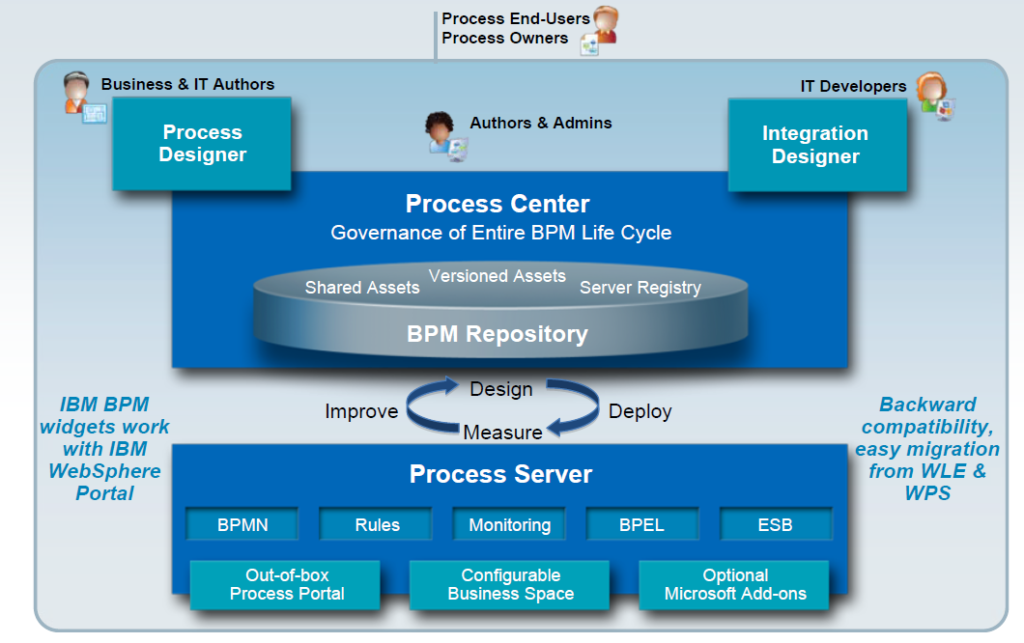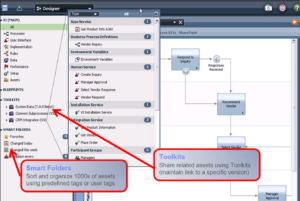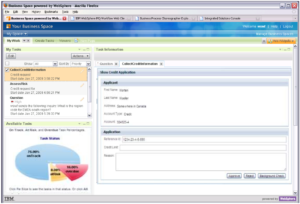I know, two TIBCO-related posts in one day, but I just received the link to the replay of the Enterprise BPM webinar that I did for TIBCO last week, along with the questions that we didn’t have time to answer during the webinar, and wanted to summarize here. First of all, my slides:
These were the questions that came in during the webinar via typed chat that are not related to TIBCO or its products; I think that we covered some of these during the session but will respond to all of them here.
Is it possible to implement BPM (business process management) without a BPMS?
How to capture process before/without technology?
These are both about doing BPM without a BPMS. I wrote recently about Elevations Credit Union (the fact that they are an IBM customer is completely immaterial in this context) that gained a huge part of their BPM success long before they touched any technology, Basically, they carved out some high-level corporate goals related to quality, modeled their value streams, then documented their existing business processes relative to those value streams. Every business process had to fit into a value stream (which was in turn related to a corporate goal), or else it didn’t survive. They saw how processes touched various different groups, and where the inefficiencies lay, and they did all of this using manual mapping on white boards, paper and sticky notes. In other words, they used the management discipline and methodology side of BPM before they (eventually) selected a tool for collaborative process modeling, which then helped them to spread the word further in their organization. There is a misperception in some companies that if you a buy a BPMS, your processes will improve, but you really need to reorient your thinking, management and strategic goals around your business processes before you start with any technology, or you won’t get the benefits that you are expecting.
In enterprises that do not have SOA implemented horizontally across the organization, how can BPM be leveraged to implement process governance in the LOB silos, yet have enterprise control?
A BPM center of excellence (CoE) would be the best way to ensure process governance across siloed implementations. I wrote recently about a presentation that I was at where Roger Burlton spoke about BPM maturity; there was some advice that he had at the end of that about organizations that had only a level 1 or 2 in process maturity (which, if you’re still very siloed, you’re probably at): get a CoE in place and target it more at change initiatives than governance. However, you will be able to leverage the CoE to put standards in place, provide mentoring and training, and eventually build a repository of reusable process artifacts.
I work in the equipment finance industry. Companies in this space are typically classified as banks/bank-affiliates, captives and independents. With a few exceptions it’s my understanding that this particular industry has been rather slow at adopting BPMS. Have you noticed this in other industries and, if so, what do you see as being the “tipping point” for greater BPMS adoption rates? Does it ultimately come down to a solid ROI, or perhaps a few peer success stories?
My biggest customers are in financial services and insurance, so are also fairly conservative. Insurance, in particular, tends to adopt technology at the very end of adoption tail. I have seen a couple of factors that can impact a slower-moving adoption of any sort of technology, not just BPMS: first, if they just can’t do business the old way any more, and have to adopt the new technology. An example of this was a business process outsourcer for back-office mutual fund transactions that started losing bids for new work because it was actually written into the RFP that they had to have “imaging and workflow” technology rather than paper-based processes. Secondly, if they can’t change quickly enough to be competitive in the market, which is usually the case when many other of their competitors have already started using the technology. So, yes, it does come down to a solid ROI and some peer success stories, but in many cases, the ROI is one of survival rather than just incremental efficiency improvements.
Large scale organizations tend to have multiple BPM / workflow engines. What insights can you share to make these different engines in different organizational BUs into an enterprise BPM capability?
Every large organization that I work with has multiple BPMS, and this is a problem that they struggle with constantly. Going back to the first question, you need to think about both sides of BPM: it’s the management discipline and methodology, then it’s the technology. The first of these, which is arguably the one with the biggest impact, is completely independent of the specific BPMS that you’re using: it’s about getting the organization oriented around processes, and understanding how the end-to-end business processes relate to the strategic goals. Building a common BPM CoE for the enterprise can help to bring all of these things together, including the expertise related to the multiple BPM products. By bringing them together, it’s possible to start looking at the target use cases for each of the systems currently in use, and selecting the appropriate system for each new implementation. Eventually, this may lead to some systems being replaced to reduce the number of BPMS used in the organization overall, but I rarely see large enterprises without at least two different BPMS in use, so don’t be fanatical about getting it down to a single system.
Typically what is the best order to implement ; first BPM and last SOA or vice versa.
I recommend a hybrid approach rather than purely top-down (BPM first) or bottom-up (SOA first). First, do an inventory in your environment for existing services, since there will almost always be some out there, even if just in your packaged applications such as ERP. While is this happening, start your BPM initiative by setting the goals and doing some top-down process modeling. Assuming that you have a particular process in mind for implementation, do the more detailed process design for that, taking advantage of any services that you have discovered, and identifying what other services need to be created. If possible, implement the process even without the services: it will be no worse from an efficiency standpoint than your current manual process, and will provide a framework both for adding services later and for process monitoring. As you develop the services for integration and automation, replace the manual steps in the process with the services.
Re: Enterprise BPM Goals – Develop, Execute, but what about Governance?
This was in response to the material on my agenda for the webinar. Yes, governance is important, but I only had 40 minutes and could barely cover the design/develop/execute parts of what we wanted to cover. Maybe TIBCO will have me back for another webinar on governance. 😉
Data/content centric processes vs. people-centric vs. EAI/integration centric re: multiple BPMS platforms. Any guidelines for when and where to demarcate?
These divisions are very similar to the Forrester divisions of the BPMS landscape from a few years ago, and grew mostly out of the different types of systems that were all lumped together as “BPMS” by the analysts in the early 2000’s. Many of today’s products offer strength in more than one area, but you need to have a good understanding of your primary use cases when selecting a product. Personally, I think that content-centric and human-centric isn’t the right way to split it: more like unstructured (case management) versus structured; even then, there is more of a spectrum of functionality in most cases than purely unstructured or purely structured. So really, the division is between processes that have people involved (human-centric) or those that are more for automated integration (system-centric), with the latter having to accommodate this wider spectrum of process types. If you have mostly automated integration processes, then certainly an integration-centric BPMS makes sense; if you have human-facing processes, then the question is a bit more complex, since you’re dealing with content/documents, process types, social/collaborative capabilities and a host of other requirements that you need to look at relative to your own use cases. In general, the market is moving towards the full range of human-facing processes being handled by a single product, although specialist product companies would differ.
Thoughts on the role of the application/solution architect within an LOB or COE vs. that of the enterprise architect assigned to the BPM domain?
An enterprise architect assigned to the BPM CoE/domain is still (typically) part of the EA team, therefore involved with the broader scope of enterprise architecture issues. An application/solution architect tends to be more product and technology focused, and in many some that is just a fancy term used for a developer. In other words, the EA should be concerned with overall strategy and goals, whereas the solution architect is focused on implementation.
Role of the COE in governance? How far does/should it extend?
The CoE is core to governance: that’s what it’s there for. At the very least, the CoE will set the standards and procedures for governance, and may rely on the individual projects to enforce that governance.
Is it really IT giving up control? In many cases, the business does whatever they do — and IT has little (or aged) information about the actual processes.
This was in reference to slide #11 in my deck about cultural issues. Certainly business can (and often do) go off and implement their own processes, but that is outside the context of enterprise-wide systems. In order to have the business be doing that within the enterprise BPMS, IT has to ensure that business can access the process discovery and modeling tools that become the front-end of process design. That way, business and IT share models of the business processes, which means that what gets implemented in the BPMS might actually resemble what is required by the business. In some cases, I see a company buy a BPMS but not allow the business users to use the business-level tools to participate in process modeling: this is usually the result of someone in IT thinking that this is beyond the capability of the business people.
Is following of any BPM notation standards part of BPM development? I saw that there was no mention of it.
There was so much that I did not have time to address with only 40 minutes or so to speak, and standards didn’t make the cut. In longer presentations, I always address the issue of standards, since a common process modeling notation is essential to communication between various stakeholders. BPMN is the obvious front-runner there, and if used properly, can be understood by both business and IT. It’s not just about process models, however: a BPMS implementation has to also consider data models, organizational models and more, around which there is less standardization.
Regarding Common UI: shouldn’t it be Common Architecture, accessed by different UIs that fit the user’s roles, knowledge, etc?
In the context of slide #6, I did mean a common UI, literally. In other words, using the BPMS’ composite application development and forms environment to create a user interface that hides multiple legacy applications behind a single user interface, so that the user deals with this new integrated UI instead of multiple legacy UIs. Your point seems to be more about persona-based (or role-based) interfaces into the BPMS, which is a valid, but different, point. That “single UI” that I mention would, in fact, be configurable for the different personas who need to access it.
How does a fully fledged BPM tool stack up against workflow tools part of other COTS application, e.g. workflow in a document management tool or in a trouble ticketing tool?
A full BPMS tends to be much more flexible than what you will find in the embedded workflow within another platform, and is more of an application development platform than just a way to control processes within that application. On the other side, the workflow within those applications are typically already fully integrated with the other business objects within them (e.g., documents, trouble tickets), so the implementation may be faster for that particular type of process. If the only type of process management that you need to do is document approvals within your document management system, it may make sense to use that rather than purchase a full BPMS; if you have broader process management needs, start looking at a more general BPMS platform that can handle more of your use cases.
How do u see BPM tools surviving when CRM tools with more or less same capability is getting widely accepted by enterprises with out-of-box processes defined?
Similar to my response to the previous question, if the processes are related only to the business objects within the CRM, then you may be better off using the workflow tools within it. However, as soon as you want to integrate in other data sources, systems or users, you’ll start to get beyond the functional capabilities of the simpler workflow tools within the CRM. There’s room in the market for both; the trick is, for customers, to understand when to use one versus the other.
What are the reasons you see for BPM tools not getting quickly and widely accepted and what are the solutions to overcome that?
There are both cost and complexity components with BPMS adoption, but a big reason before you even start looking at tools is moving your organization to a process-driven orientation, as I discussed above. Once people start to look at the business as end-to-end processes, and those processes as assets and capabilities that the business offers to its customers, there will be a great pull for BPMS technologies to help that along. Once that motivation is in place, the cost and complexity barriers are still there, but are becoming less significant: first of all, more vendors are offering cloud-based versions of their software that allow you to try it out – and even do your full development and testing – without capital expenditures. If they offer the option, you can move your production processes on-premise, or leave them in the cloud to keep the total cost down. As for complexity, the products are getting easier to use, but are also offering a lot more functionality. This shifts the complexity from one of depth (learning how to do a particular function) to breadth (learning what all the functions are and when to use which), which is still complex but less of a technological complexity.
Is it possible to start introducing and implementing BPM in one department or module only and then extending the BPM to other departments or modules? Or this should be the enterprise wide decisions since it involves heavy cost to bring BPM technologies.
Almost every organization that I work with does their BPM implementation in one department first, or for one process first (which may span departments): it’s just not possible to implement everything that you will ever implement in BPM at the same time, first time. There needs to be ROI within that first implementation, but you also have to look at enterprise cost justification as with any horizontal technology: plan for the other projects that will use this, and allocate the costs accordingly. That might mean that some of the initial costs come from a shared services or infrastructure budget rather than the project budget, because they will eventually be allocated to future projects and processes.
How difficult would it be to replace legacy workflow system with BPM?
It depends (that’s always the consultant’s answer). Seriously, though, it depends on the level of integration between the existing workflow system and other systems, and how much of the user interface that it provides. I have seen situations where a legacy workflow system is deeply embedded in a custom application platform, with fairly well-defined integration points to other systems, and the user interface hiding the workflow system from the end user. In this case, although it’s not trivial, it is a straightforward exercise to rip out the workflow system since it is being used purely as a process engine, replace it with a new one, refactor the integration points so that the new system calls the other systems in the environment (usually easier since modern BPMS’ have better integration capabilities) and refactor the custom UI so that it calls the new BPMS (also usually easier because of updated functionality). That’s the best case, and as I said, it’s still not trivial. If the legacy workflow system also provides the user interface, then you’re looking at redeveloping your entire UI either in the new BPMS or in some other UI development tool, plus the back-end systems integration work. A major consideration in either case is that you don’t just want to replace the same functionality of the old workflow system, since the new BPMS will have far greater functionality: you need to think about how you are going to leverage capabilities such as runtime collaboration that never existed in the old system, in order to see the greatest benefit from the upgrade.
Is it possible to switch between BPM vendors without having pain?
No. Similar to the previous answer, this is a non-trivial exercise, and depending on how much of the functionality of the BPMS that you were using, could be pretty much a complete redevelopment. If the BPMS was used primarily for orchestration of automated processes, it will be much easier, but as soon as you get into custom integration/orchestration and user interfaces, it gets a lot more complicated (and painful).
Do we really need to go for BPM in a situation where we need only integration orchestration only?
One end of the BPMS market is integration-centric systems, which primarily do just integration orchestration. The advantage of using a BPMS for this instead of orchestrating directly in application code is that you get all of the other stuff that comes with the BPMS “for free”: graphical process modeling, execution monitoring, process governance and whatever other goodies are in the BPMS. It’s not really free, of course, but it’s valid to consider a comparison of all of that functionality against what parts of it you would have to custom-build if you were to do the orchestration in code.
That’s it for the Q&A. If you listen to the replay, or were on the live broadcast, my apologies for the rushed beginning: I got off on the wrong foot out of the gate, but settled down after the first few minutes.
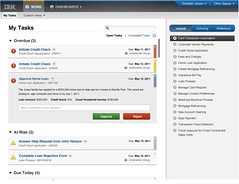 Social collaboration to allow users to work together on tasks via real-time interactions, view activity streams, and locate experts. That manifests in the redesigned task interface, or “coach”, with a sidebar that includes task details, the activity stream for the entire process, and experts that are either recommended by the system based on past performance or by others through manual curation. Experts can be requested to collaboration on a task with another user – it includes presence, so that you can tell who is online at any given time – allowing the expert to view the work that the user is doing, and offer assistance. Effectively, multiple people are being given access to same piece of work, and updates made by anyone are shown to all participants; this can be asynchronous or synchronous.
Social collaboration to allow users to work together on tasks via real-time interactions, view activity streams, and locate experts. That manifests in the redesigned task interface, or “coach”, with a sidebar that includes task details, the activity stream for the entire process, and experts that are either recommended by the system based on past performance or by others through manual curation. Experts can be requested to collaboration on a task with another user – it includes presence, so that you can tell who is online at any given time – allowing the expert to view the work that the user is doing, and offer assistance. Effectively, multiple people are being given access to same piece of work, and updates made by anyone are shown to all participants; this can be asynchronous or synchronous. 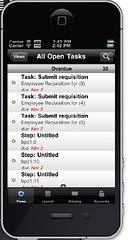 Mobile access via an iOS application that can interface with Blueworks Live and IBM BPM; if you search for “IBM BPM” in the iTunes app store (but not, unfortunately, in the Android Market), you’ll find it. It supports viewing the task list, task completion, attach documents and add comments. They are considering releases the source code to allow developers to use it as a template, since there is likely to be a demand for a customized or branded version of this. In conjunction with this, they’ve released a REST API tester similar to the sort of sandbox offered by Google, which allows developers to create REST-based applications (mobile or otherwise) without having to own the entire back-end platform. This will certainly open up the add-on BPM application market to smaller developers, where we are likely to see more innovation.
Mobile access via an iOS application that can interface with Blueworks Live and IBM BPM; if you search for “IBM BPM” in the iTunes app store (but not, unfortunately, in the Android Market), you’ll find it. It supports viewing the task list, task completion, attach documents and add comments. They are considering releases the source code to allow developers to use it as a template, since there is likely to be a demand for a customized or branded version of this. In conjunction with this, they’ve released a REST API tester similar to the sort of sandbox offered by Google, which allows developers to create REST-based applications (mobile or otherwise) without having to own the entire back-end platform. This will certainly open up the add-on BPM application market to smaller developers, where we are likely to see more innovation.  Social interface for business people to interact with rules design: decisions are assets that are managed and modified, and the event stream/conversation shows how those assets are being managed. This interface makes it possible to subscribe to changes on specific rules.
Social interface for business people to interact with rules design: decisions are assets that are managed and modified, and the event stream/conversation shows how those assets are being managed. This interface makes it possible to subscribe to changes on specific rules. 
